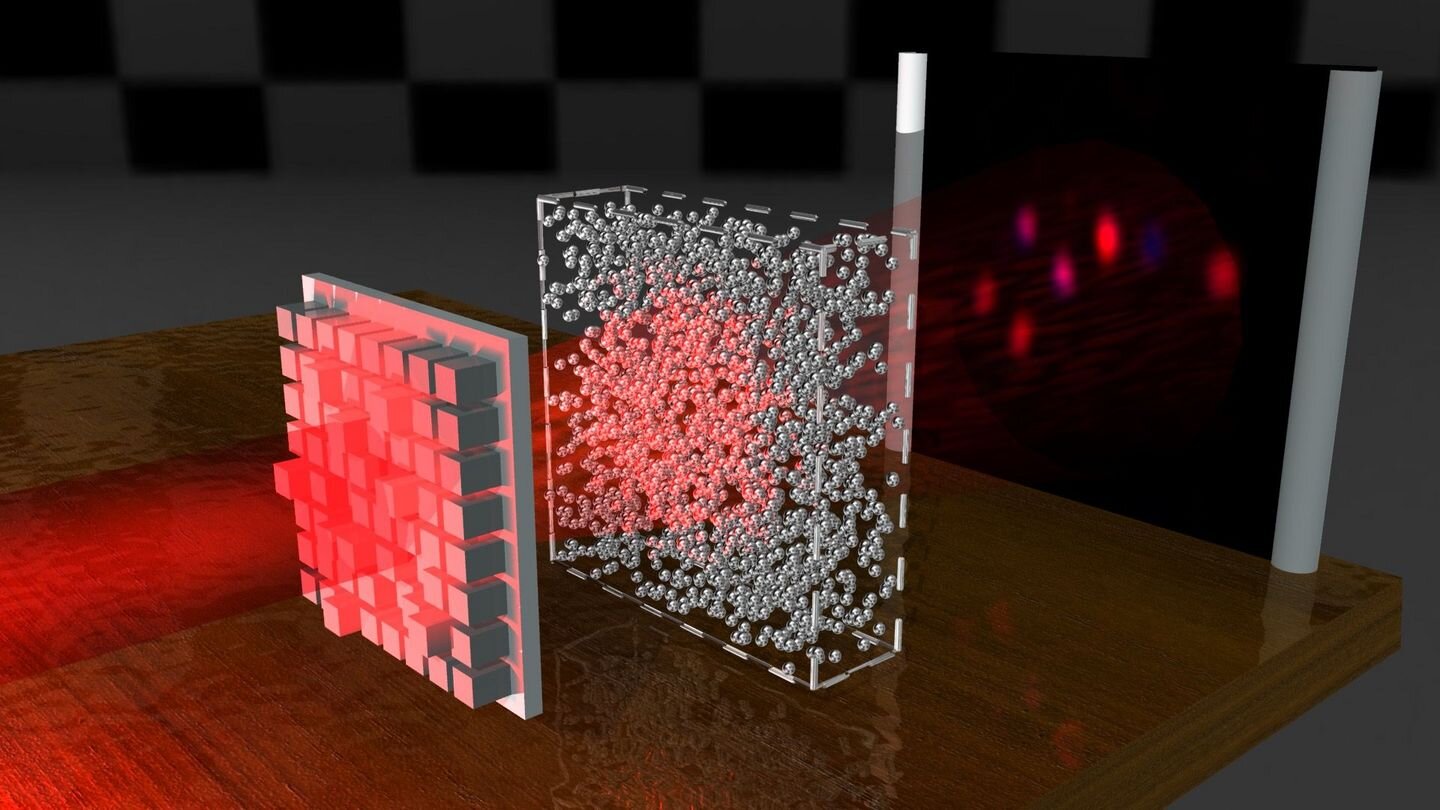
Credit: Allard Mosk / Matthias Kühmayer
Why is sugar not transparent? Because light that penetrates a piece of sugar spreads, changes and deflects in a very complicated way. As a research team from the TU Vienna (Vienna) and the University of Utrecht (The Netherlands) have now shown, there is a class of very special light waves to which it does not apply: for any specific disturbed medium – such as the sugar cube you may just put in your coffee – custom-made light rays can be built that are practically not altered by this medium, but only weakened. The ray of light penetrates the medium and on the other side comes a light pattern that has the same shape as if the medium is not there at all.
This idea of ’scattering-invariant lighting methods’ can also be used to specifically examine the inside of objects. The results are now published in the journal Nature Photonics.
An astronomical number of possible waveforms
The waves on a turbulent water surface can take an infinite number of different shapes – and in a similar way, light waves can also be made in innumerable shapes. “Each of these light wave patterns is changed and deviated from in a very specific way if you send them through a disordered medium,” explains prof. Stefan Rotter from the Institute for Theoretical Physics at the TU Vienna.
Together with his team, Stefan Rotter develops mathematical methods to describe such light scattering effects. The expertise to produce and characterize such complex light fields was demonstrated by the team around prof. Allard Mosk of Utrecht University contributed. “As a light scattering medium, we used a layer of zinc oxide – an opaque, white powder of completely randomly arranged nanoparticles,” explains Allard Mosk, head of the experimental research group.
First, you need to characterize this layer exactly. You shine very specific light signals through the zinc oxide powder and measure how it arrives at the detector behind it. From this you can then deduce how any other wave is changed by this medium – in particular you can specifically calculate which wave pattern is changed by this zinc oxide layer, exactly as if wave scattering in this layer was completely absent.
“As we were able to show, there is a very special class of light waves – the so-called scattering-unchanging light modes that produce exactly the same wave pattern at the detector, regardless of whether the light wave was sent only through the air or penetrated the complex zinc oxide layer,” says Stefan Rotter. “In the experiment, we see that the zinc oxide does not actually change the shape of these light waves – it just gets a little weaker overall,” explains Allard Mosk.

For comparison: the ray of light without scattering. Credit: Allard Mosk / Matthias Kühmayer
A constellation at the light detector
As special and rare as these scatter-unchanging light modes can be, with the theoretically unlimited number of possible light waves, one can still find plenty of them. And if you combine several of these scatter-unchanging light modes in the right way, you will get a scatter-unchanging waveform again.
“In this way, at least within certain limits, you are free to choose which image you want to send through the object without interference,” says Jeroen Bosch, who participated in the experiment as a Ph.D. student. “For the experiment, we chose a constellation as an example: The Big Dipper. And indeed, it was possible to determine a scattering-invariant wave that sends an image of the Big Dipper to the detector, regardless of whether the light wave is scattered. through the zinc oxide layer or not. To the detector, the light beam in both cases looks almost the same. “
A peek inside the cell
This method of finding light patterns that penetrate through an object largely undisturbed can also be used for imaging procedures. “In hospitals, X-rays are used to look inside the body – they have a shorter wavelength and can therefore penetrate our skin. But the way a light wave penetrates an object does not only depend on the wavelength , but also of the waveform, “says Matthias Kühmayer, who as Ph.D. work. student on computer simulations of wave propagation. “If you want to focus light on an object at certain points, our method offers completely new possibilities. We were able to show that the light distribution within the zinc oxide layer can be specifically controlled according to our approach.” This could be interesting for biological experiments, for example, where you want to set light on very specific points to look deep into cells.
What the joint publication of scientists from the Netherlands and Austria already shows is how important international collaboration between theory and experiment is to bring about progress in this field of research.
Optimal information about the invisible
Pritam Pai et al. Distribution of unchanging modes of light in complex media, Nature Photonics (2021). DOI: 10.1038 / s41566-021-00789-9
Provided by Vienna University of Technology
Quotation: Researchers create light waves that can penetrate even opaque materials (2021, April 12) Retrieved April 12, 2021 from https://phys.org/news/2021-04-penetrate-opaque-materials.html
This document is subject to copyright. Except for any fair trade for the purpose of private study or research, no portion may be reproduced without the written permission. The content is provided for informational purposes only.
